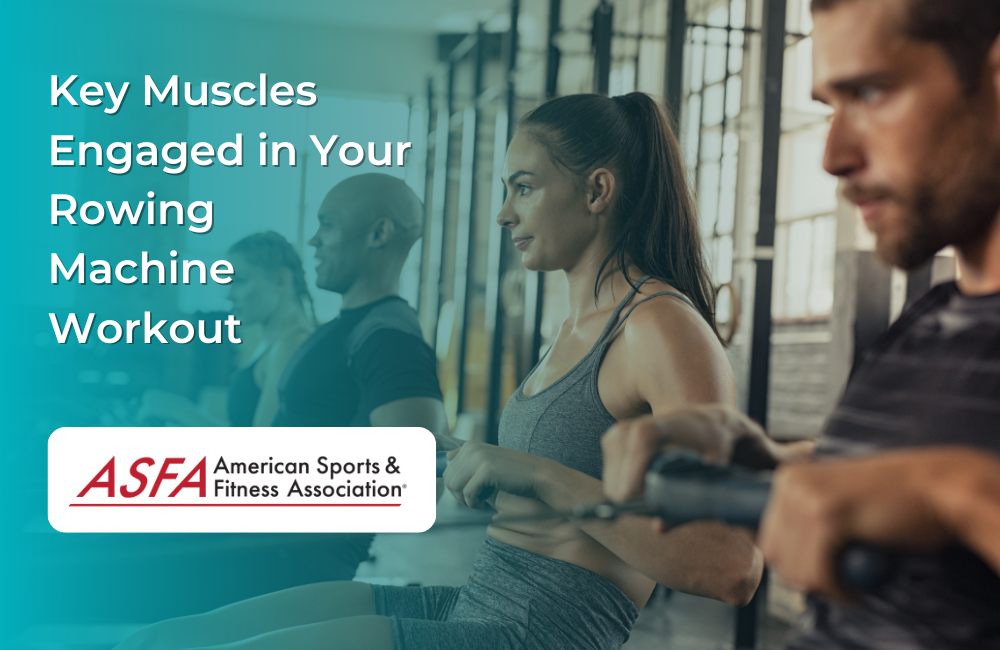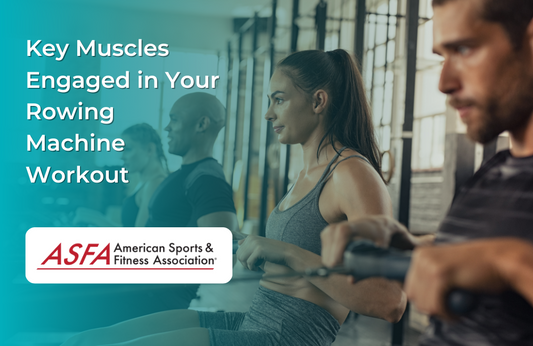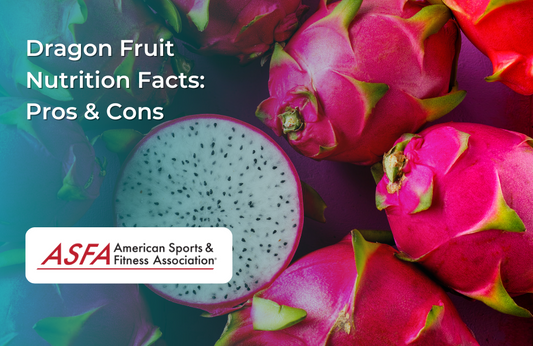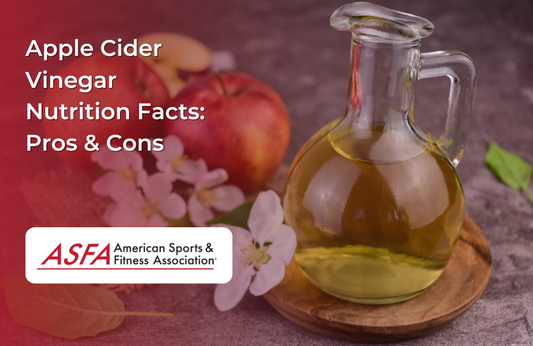A rowing machine targets multiple muscle groups, providing a full-body workout. It engages the upper body, core, and lower body muscles effectively. In this article, we will explore what does a rowing machine target, breaking down which specific muscles are worked and how rowing benefits your overall fitness.
Key Takeaways
-
Rowing machines engage up to 86% of your muscles, providing a powerful full-body workout that strengthens upper and lower body as well as core muscles.
-
Mastering the four phases of the rowing stroke—Catch, Drive, Finish, and Recovery—optimizes muscle engagement and enhances workout effectiveness.
-
Incorporate interval training and adjust resistance during workouts to maximize cardiovascular fitness, muscle growth, and calorie burning.
Major Muscle Groups Engaged by Rowing Machines
Rowing machines are designed to provide a comprehensive workout that strengthens and tones both upper and lower body muscles. Engaging up to 86% of your muscles, rowing machines provide incredibly effective full-body workouts. When you row, various muscle groups are worked simultaneously, not just one part of your body. Rowing machine work provides a unique way to achieve fitness goals.
The primary muscle groups engaged during a rowing machine workout include the upper body, lower body, and core muscles. This diverse muscle engagement makes rowing an excellent full body workout for those looking to improve their overall fitness and build muscle mass.
Here’s how rowing works each muscle group and the benefits you can gain from this exercise routine.
Upper Body Muscles
The upper body muscles are significantly targeted by rowing. Specific muscles involved include the biceps, deltoids, rotator cuff, and forearm muscles. The pulling motion of rowing heavily engages the biceps, providing elbow flexion and generating stroke power, while deltoids assist with shoulder movement.
Rowing also strengthens shoulder and back muscles, enhancing upper body stability and performance during workouts.
Core Muscles
Core muscles are crucial for stabilizing the body during rowing strokes and aid in power transfer from the legs to the arms. The core muscles engaged during rowing include the rectus abdominis, erector spinae, transverse abdominus, and obliques.
These muscles help synchronize upper and lower body movements, improving stability and power transfer.
Lower Body Muscles
The primary lower body muscles engaged while using a rowing machine are the glutes, quadriceps, hamstrings, and calves. Rowing strengthens and builds these muscles, contributing to improved physical performance.
During the drive phase, the glutes and hamstrings contribute to knee flexion and hip extension, providing powerful leg drive.
The Four Phases of the Rowing Stroke and Muscle Engagement
Understanding the four phases of the rowing stroke maximizes muscle engagement and prevents common rowing mistakes. The rowing stroke is made up of four phases. These are the Catch, Drive, Finish, and Recovery phases. Each phase engages different muscle groups and requires proper technique to ensure an effective workout.
Effective rowing begins with the legs, emphasizing their importance over the arms. Here’s how each phase engages various muscle groups and how to optimize your technique.
The Catch Phase
During the Catch phase, major back muscles such as the rhomboids, trapezius, and latissimus dorsi are activated. Shoulder blades and leg muscles are also targeted, enhancing stability and power.
The Catch phase, the starting position in rowing, sets the stage for a powerful stroke.
The Drive Phase
Before: The main muscles involved in the Drive phase include the quadriceps, glutes, hamstrings, and core muscles. During this phase, the quadriceps engage during the leg push-off, while the hamstrings are activated during the leg drive of the stroke.
After: The main muscles involved in the Drive phase include:
-
Quadriceps, which engage during the leg push-off
-
Glutes
-
Hamstrings, which are activated during the leg drive of the stroke
-
Core muscles
Both the glutes and abdominal muscles play a crucial role in maintaining stability and generating power.
The Finish Phase
During the Finish Phase, the primary upper body muscles engaged are the biceps and shoulders. This phase also relies on core muscles for stabilization, enhancing form and efficiency.
Maintaining control in the Finish Phase allows for better muscle activation and maximizes the effectiveness of the rowing stroke.
The Recovery Phase
The main muscles involved during the Recovery phase are the triceps and hip flexors. This phase involves a slow sequence of movements where the arms retract first, followed by the body, and then the legs.
Benefits of Rowing Machine Workouts
Rowing machines offer numerous benefits, including muscle building, improved cardiovascular fitness, and calorie burning. Rowing workouts strengthen the heart and lungs, contributing to overall health. Rowing workouts can be tailored in intensity and duration to specifically target different fitness goals and enhance muscle engagement.
A common misconception about rowing machines is that they are primarily an upper-body exercise. However, as we’ve seen, rowing is a total body workout that engages multiple muscle groups simultaneously, promoting strength, endurance, and cardiovascular fitness.
Cardiovascular Fitness
Rowing enhances cardiovascular health by requiring the heart to pump more blood, which improves heart strength over time.
Interval workouts on a rowing machine boost cardiovascular fitness and muscle endurance by alternating between high-intensity efforts and rest in your fitness routine.
Weight Loss and Calorie Burning
Rowing can lead to significant calorie expenditure, contributing to fat loss when paired with a healthy diet. Rowing workouts can lead to significant reductions in body fat when combined with proper nutrition.
Posture Improvement
Rowing improves posture by developing strength in the back and shoulder muscles, which support spinal alignment. Regular rowing enhances postural alignment by strengthening back and shoulder muscles.
Common Mistakes to Avoid for Effective Muscle Engagement
Proper form and technique are crucial for maximizing the benefits of rowing. Overusing arm muscles while rowing can lead to serious injury. Adjusting the rowing machine’s damper setting is critical; a high setting can place more stress on muscles and lead to exhaustion.
For beginners, a recommended damper setting range is between 3-5.
Overusing Arm Muscles
To use arms and legs correctly during rowing, push with your legs first, pivot at the hips, and then pull your arms into your chest.
If muscle engagement is taken away from larger muscle groups, expect less muscle building and potential imbalances.
Poor Posture
A neutral spine prevents injuries and ensures effective rowing. Slouching during the recovery phase prevents full leg activation and can lead to low back pain and increased injury risk.
Rushing Through Strokes
A controlled rhythm is essential for an effective rowing workout. A consistent stroke rhythm maximizes muscle engagement and energy efficiency. Rushing through the rowing stroke disrupts rhythm and increases the risk of injury.
Sample Rowing Machine Workouts
To get the most out of your rowing machine workouts, consider incorporating different types of workouts such as interval training, long-distance rowing, and strength-focused rowing.
Tracking key rowing metrics is crucial for measuring performance and progress.
Interval Training
Interval training alternates periods of high-intensity exercise and rest or lower-intensity exercise, benefiting cardiovascular fitness. These workouts enhance cardiovascular health by engaging the heart at various intensities, which strengthens the heart muscles and improves blood circulation.
Long-Distance Rowing
A good stroke rate for steady-state rowing is between 20 to 22 strokes per minute. Steady-state rowing emphasizes a consistent and moderate pace, helping to build endurance over time.
Strength-Focused Rowing
Strength-focused workouts involve adjusting the rowing machine’s resistance to promote muscle growth and force production.
Summary
In summary, rowing machines offer a comprehensive workout that targets a wide range of muscle groups, enhances cardiovascular fitness, aids in weight loss, and improves posture. By understanding the muscle engagement during different phases of the rowing stroke and avoiding common mistakes, you can optimize your rowing workouts for maximum benefit.
Whether you’re looking to build muscle, improve your cardiovascular health, or simply add variety to your fitness routine, rowing is an excellent choice. Start incorporating rowing into your exercise routine today and experience the numerous benefits it offers.
Frequently Asked Questions
What muscles does a rowing machine target?
Using a rowing machine effectively engages your upper body, core, and lower body muscles, providing a full-body workout that strengthens and tones. Embrace this powerful exercise to transform your fitness routine!
How does rowing improve cardiovascular fitness?
Rowing is a powerful way to boost your cardiovascular fitness by making your heart work harder, strengthening it over time. Incorporating interval workouts on a rowing machine can further amplify these benefits, helping you reach your fitness goals faster!
Can rowing help with weight loss?
Absolutely, rowing is an effective way to burn calories and promote fat loss, especially when combined with a healthy diet. Embrace this energizing workout and watch your body transform!
What are common mistakes to avoid while using a rowing machine?
To maximize your workout and avoid injury, focus on using your legs, maintain good posture, and take your time with each stroke. Remember, proper technique is key to getting the most out of your rowing session!
What are some sample rowing machine workouts?
To maximize your rowing machine workouts, try incorporating interval training for intensity, long-distance rowing for endurance, and strength-focused sessions to build muscle. These variations will keep your routine exciting and effective!





